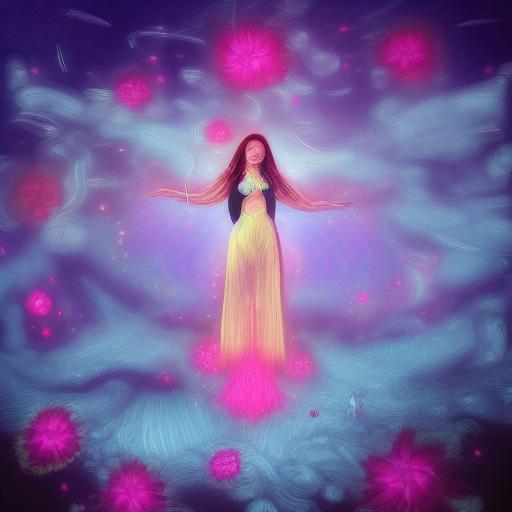How to write this prompt?
Here’s a breakdown of the prompt and how each individual part influences the image being generated:
- “Psychedelic Art, the artwork is a digital 2D fantasy art portraying a woman floating among flowers in space” – This sets the subject matter of the image. The AI will generate an image that features a woman floating among flowers in space, with a psychedelic and fantastical art style.
- “The camera angle used is an aerial view, emphasizing the dreamlike quality of the scene” – This is a specific instruction for the composition of the image. The AI will create an image that has an aerial view, emphasizing the dreamlike quality of the scene and creating a sense of floating or weightlessness.
- “The lighting used in this artwork is a blacklight, creating an otherworldly and eerie ambiance” – This is a specific instruction for the lighting of the image. The AI will create an image that has a blacklight, creating an otherworldly and eerie ambiance. This can add to the overall psychedelic and fantastical feel of the image.
- “The colors used in this artwork include shades of blue and green, adding to the cosmic aesthetic” – This sets the color palette for the image. The AI will generate an image that features shades of blue and green, which can create a cosmic and otherworldly aesthetic.
Overall, the prompt is a combination of specific instructions and more general suggestions for the AI to follow. Each individual part of the prompt contributes to the overall image being generated. By breaking down the prompt and analyzing each part, you can understand how to write a prompt that effectively communicates your desired image to the AI.
What is the significance of using a blacklight in the image?
Using a blacklight in the image can create an otherworldly and eerie ambiance, adding to the overall psychedelic and fantastical feel of the image. The blacklight can also enhance certain colors, making them appear brighter or more vibrant.
How to create a cosmic aesthetic in a digital artwork?
To create a cosmic aesthetic in a digital artwork, you can use colors such as blue, green, and purple, which are often associated with space and the cosmos. You can also incorporate elements such as stars, galaxies, and other celestial objects to create a sense of depth and dimension.
Who are some famous artists known for creating psychedelic art?
Some famous artists known for creating psychedelic art include Alex Grey, Salvador Dali, and Yayoi Kusama. These artists are known for their use of vibrant colors, abstract patterns, and surreal imagery, which are common elements in psychedelic art.
Do I need to have technical knowledge or programming skills to use AI art generation prompts?
No, you do not need to have technical knowledge or programming skills to use AI art generation prompts. Many AI art generation tools are designed to be user-friendly and accessible, allowing anyone to create AI-generated art without any technical expertise. However, having some basic knowledge of art and design principles can be helpful in creating more effective prompts and in analyzing the generated art.
Are there any copyright issues with using AI-generated art?
Yes, there can be copyright issues with using AI-generated art. The ownership of the copyright in AI-generated art is a complex legal issue, as it involves questions of authorship and originality. In some cases, the copyright in AI-generated art may belong to the person who created the AI algorithm or to the person who trained the AI algorithm. In other cases, the copyright may belong to the person who provided the input or the prompt that the AI used to generate the art.
To avoid any copyright issues, it is important to ensure that you have the necessary rights and permissions to use the AI-generated art. This may involve obtaining permission from the copyright owner or ensuring that the AI tool you are using provides clear guidelines on copyright ownership. Additionally, it is important to be aware of any potential ethical issues surrounding the use of AI-generated art, such as concerns around bias and representation.
In summary, while AI art generation prompts can be a useful tool for creating unique and interesting artwork, it is important to be aware of potential copyright issues and ethical concerns. By being mindful of these considerations, you can ensure that you are using AI-generated art in a responsible and respectful manner.
Visualize your ideas like never before with the power of AI-generated art and design tools from Visual Paradigm Online. Elevate your designs to the next level by effortlessly integrating stunning graphics with just a few clicks. With a user-friendly interface and a vast selection of design templates and assets at your disposal, you can explore and experiment with various styles and layouts until you create the perfect masterpiece. Discover the limitless potential of AI-generated art and transform your creative vision into reality with Visual Paradigm Online.


